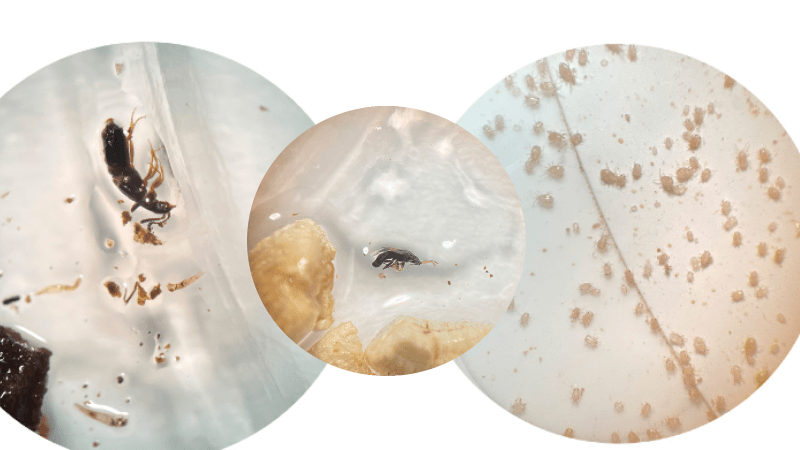
Biocontrol: How? Why? When? Yes, I Can!
Good bugs. Bad bugs. Pop quiz: can we tell them all apart? Let’s talk about the good guys doing all the work for us while controlling the bad guys … biocontrol. Starting a biocontrol program can seem a little daunting, as that is where I was nine years ago starting this journey, and not knowing where to start on such a grand scale.
Biological control can be defined as the deliberate use of natural enemies, parasites, pathogens, and competitors to suppress and maintain populations of a target pest species (insects, mites, weeds, plant pathogens and other pest organisms). Biological control is a practical option for suppressing — and, in some situations, eradicating — pest populations because it is safe and easy to use. Other reasons for starting a biological control program include:
• It can be very cost effective and environmentally sound when compared to broad-spectrum pesticides that are often used.
• They reduce the use of conventional pesticides.
• Once populations are established, it becomes self-sustaining.
• They can be target specific.
• They can be incorporated into existing integrated pest management programs.
The key is to start small with just one pest you want to control and/or one specific growing area (e.g., greenhouse A versus greenhouse B to focus on). Scouting is the first and most crucial step to any biological control program. Understanding and correctly identifying your pest population determines which natural predators to bring in and how frequently. This frequency can be determined by the time of year (spring versus winter), growing capacity and insect life stages seen during scouting. Some of the most common greenhouse insect pests include Western flower thrips, Frankliniella occidentalis (Pergande); green peach aphids, Myzus persicae (Sulzer); greenhouse whitefly, Trialeurodes vaporarorium (Westwood); sweet potato whitefly B-biotype, Bemisia tabaci (Gennadius); fungus gnat, Bradysia coprophila (Linter); and twospotted spider mites, Tetranychus urticae (Koch).
Once pests have been identified, selecting the best natural predator is crucial, whether that is a generalist feeder or species-specific feeder. Below is a great starter list of biological control predators for each pest, and there are now multiple commercial companies that supply biological control agents (BCAs) within the U.S. A few examples include Beneficial Insectary, Biobest, Bioline, Koppert Biological Systems, and Sound Horticulture.
• Western Flower Thrips
• Nematodes, Steinernema feltiae
• Minute Pirate Bugs, Orius insidiosus
• Brown Lacewings, Sympherobius barberi
• Rove Beetle, Dalotia coriaria
• Amblyseius swirskii (beneficial mite)
• Green Peach Aphids
• Green Lacewings, Chrysoperla rufilabris
• Lady bird beetle, Adalia bipunctata
• Greenhouse Whitefly and Sweet Potato Whitefly B-biotype
• Parasitic wasp, Encarsia formosa
• Lady bird beetle, Delphastus catalinae
• Fungus Gnat
• Minute Pirate Bugs, Orius insidiosus
• Nematodes, Steinernema feltiae
• Rove Beetle, Dalotia coriaria
• Twospotted Spider Mites
• Neoseiulus californicus (beneficial mite)
• Phytoseiulus persimilis (beneficial mite)
• Galendromus occidentalis (beneficial mite)
• Stethorus punctillum (beneficial beetle)
• Amblyseius swirskii (beneficial mite)
• Rove Beetle, Dalotia coriaria
• Minute Pirate Bugs, Orius insidiosus

Now that we have all the parts figured out (good guys versus bad guys), how do we put all that together and make sure we are applying enough and correctly? Thankfully, every entomologist I have met is very willing to walk you through the process of starting a biocontrol program … but you need a few things first. You need scouting results and your growing square footage.
 Above is an example schedule of my growing area for a 13-week period using four beneficials to control three insect pests (spider mites, fungus gnats and thrips). Making a schedule like this helps when things need to be ordered and outlines how often you should be applying your predators. It also allows you to make notes if there are increases in pest populations during the weeks of non-applications. When your shipment of BCAs arrive, they should be inspected to ensure they have arrived alive with no heat and/or cold damage.
Above is an example schedule of my growing area for a 13-week period using four beneficials to control three insect pests (spider mites, fungus gnats and thrips). Making a schedule like this helps when things need to be ordered and outlines how often you should be applying your predators. It also allows you to make notes if there are increases in pest populations during the weeks of non-applications. When your shipment of BCAs arrive, they should be inspected to ensure they have arrived alive with no heat and/or cold damage.
Nematodes are the easiest to apply and can be incorporated into your fertigation system. Remember to remove the filter if you are using a Dosatron, and to agitate the solution in your bucket, as the nematodes will sink to the bottom of your bucket. Rove beetles and minute pirate bugs arrive with a carrier-filler in the container so using a 0.25 teaspoon assists with application to the designated containers. These applications don’t need to be applied pot-to-pot, but scattered, so that good coverage is achieved. Beneficial mites also come in a carrier-filler, and this can be sprinkled over containers and trays. You may not see all the beneficials, but they are there!
As we all know, habits are hard to break, and spraying pesticide chemicals will be the hardest yet for all growers. The true struggle is combining a successful biological program and conventional pesticide sprays that won’t kill all the biological insects you have just applied to your crops. “Softer” pesticide chemicals will ensure a higher survival rate of biocontrol insect populations, and these typically include soaps. Before applying any BCAs, it is important to phase out usage of material in the organophosphate, carbamate and pyrethroid chemical classes three to four months prior to releasing natural enemies, as these materials can persist for many months. An excellent online resource to check biological predator compatibility with chemical compatibility can be found on Biobest’s website (www.biobestgroup.com/en/side-effect-manual). This website allows you to search by both active ingredient and the commercial product name of the pesticide chemical, and by the beneficial organism.
It’s two weeks later. You’ve applied your BCAs. And you’ve applied some “softer” chemicals, hoping you didn’t kill the predators. Now what? Scouting! Always back to scouting. But now we are looking for beneficials AND pests, and we hope for more in that first group.
An important note to remember about starting a biocontrol program is that it is not magic and doesn’t happen overnight. It will take a few weeks to see the transition from chemical control to natural predator control. Stick it out. Fight the urge to spray with a “hard” chemical. It will all be worth it. For you. For me. For the plants. For the environment.
Sidebar: A Word with the Buglady
If you aren’t currently using biological control agents (BCAs) in your greenhouse, starting can feel overwhelming. If you have tried incorporating BCAs into your pest management program, you may be looking for some tips to be more successful. To help, I reached out to Suzanne Wainwright-Evans at Buglady Consulting to learn how to incorporate BCAs into your current program and increase your chances of success.
Wainwright-Evans, “The Buglady,” says that trends in pest management are moving toward BCAs, so if you are currently not using them, don’t get left behind because that’s where the market is going. It can take some time to overcome the learning curve because you are working with living things in different environmental growing conditions; it takes time to figure out the right adjustments to have a successful program.
“There are no standardized ‘cookie-cutter’ programs that work for every situation,” she says. Having patience with BCAs is important when working your way to success.
IF YOU’RE JUST GETTING STARTED
Generally, you want to start with BCAs that are easy to work with and have a high success rate, like beneficial nematodes, according to Wainwright- Evans. Applied like a conventional pesticide, nematodes are compatible with most current pesticide programs, so you don’t have to make changes to begin using them. Nematodes are a critical part of programs for Western flower thrips and onion thrips — being seen in greenhouses more often these days, Wainwright-Evans says. Nematodes have been available for decades, the product quality has consistently become better and the key target pest list continues to expand as more research is done, she says.
The second choice Wainwright-Evans recommends for beginners is predatory mites for spider mite management. Often it can be cheaper than spraying for the pest because spider mites have a high reproductive rate, which could require a lot of pesticides over time. Predatory mites — like Phytoseiulus persimilis — have been used since the 1960s, so over 60 years of experience gives us more information, making it easier to develop a success program in your greenhouse.
TIPS FOR SUCCESS WITH BCAs
Don’t be afraid to ask for qualifications. When you are looking for advice on any topic, it’s important to be sure the person you are speaking with is knowledgeable and can provide you with the best information. Ask how they got their experience, how long they have been working with BCAs, and for other examples that make them qualified to help you in your biocontrol journey, advises Wainwright-Evans.
Make sure your distributor isn’t a re-distributor or a re-re-distributor. Some companies that seem reputable online or have great search engine optimization will pop up in your search for BCAs, but they could just be handling the paperwork of the order and are not the actual insectary (i.e., drop shipping), says Wainwright-Evans. Furthermore, she adds that some companies are ordering the BCAs from an insectary, having them shipped to their location, changing the labels and then sending them to you. For better success, know the source of your product.
For an enhanced reading experience, view this article in our digital edition by clicking here.









 Video Library
Video Library 


















